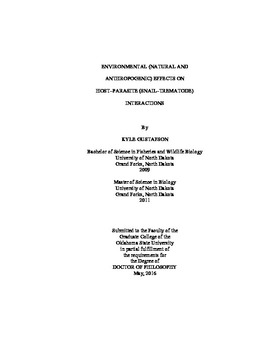| dc.contributor.advisor | Bolek, Matthew G. | |
| dc.contributor.author | Gustafson, Kyle Douglas | |
| dc.date.accessioned | 2017-02-22T22:11:55Z | |
| dc.date.available | 2017-02-22T22:11:55Z | |
| dc.date.issued | 2016-05 | |
| dc.identifier.uri | https://hdl.handle.net/11244/48938 | |
| dc.description.abstract | This dissertation explored environmental effects on host-parasite interactions. Chapter 2 was published in Ecotoxicology and assessed the effects of the herbicide atrazine on freshwater snails. The results indicated that snails are affected by atrazine at the subcellular and cellular levels. However, effects at those levels were not transitive to effects on individual snail fitness or on snail populations. Chapter 3 was published in Journal of Parasitology and explored the dose-response effects of trematodes on snails. The results indicated that as the trematode egg dose increased, the probability of snail reproduction and survival decreased; however, the probability of establishing an infection increased. Chapter 4 was published in Parasitology Research and addressed the effects of atrazine on trematode transmission and host-parasite interactions. The results showed that atrazine reduced infected snail survival at higher atrazine concentrations, resulting in fewer cercariae being produced. On top of that, atrazine reduced the infectivity of worms to the final host. Combined, these effects reduced the transmission of an amphibian trematode. Chapter 5 was published in Evolutionary Ecology Research and was a common garden experiment assessing the effects of environment on snail shell morphology. The shell shape of offspring from stream and wetland snails converged within a single generation whereas shell size took 2 generations to converge, suggesting the two ecomorphs are a single species. Sequence data confirmed they were the same species. Chapter 6 was published in Journal of Morphology and assessed the interactive effects of the environment and parasitism on snail shell morphology. The results showed that the environment was the major driver of snail shell morphology. Parasitism played a secondary role and only affected shell crush resistance in stream snails. Trematode communities were significantly different between wetland and stream snails but the effect on shell crush resistance was not driven by differences in trematode communities. | |
| dc.format | application/pdf | |
| dc.language | en_US | |
| dc.rights | Copyright is held by the author who has granted the Oklahoma State University Library the non-exclusive right to share this material in its institutional repository. Contact Digital Library Services at lib-dls@okstate.edu or 405-744-9161 for the permission policy on the use, reproduction or distribution of this material. | |
| dc.title | Environmental (natural and anthropogenic) effects on host-parasite (snail-trematode) interactions | |
| dc.contributor.committeeMember | Belden, Jason B. | |
| dc.contributor.committeeMember | Dzialowski, Andrew R. | |
| dc.contributor.committeeMember | Davis, Craig A. | |
| osu.filename | Gustafson_okstate_0664D_14498.pdf | |
| osu.accesstype | Open Access | |
| dc.type.genre | Dissertation | |
| dc.type.material | Text | |
| thesis.degree.discipline | Zoology | |
| thesis.degree.grantor | Oklahoma State University | |
